Reading Time: 5 minutes
Santiniketan, a vision by Tagore, showcases India’s artistic soul, starting with Ajanta cave copies in 1909 and reaching its peak with Benode Behari Mukherjee’s murals, elucidates Monika, exclusively for Different Truths.
Santiniketan, the tranquil abode founded by Rabindranath Tagore, is more than just a serene premises. It is an epitome of India’s rich artistic heritage, adorned with monumental murals that tell the story of the nation’s soul. The genesis of this artistic journey can be traced back to the winter of 1909 when Lady Herringham, a British artist and connoisseur, led a team to meticulously copy the renowned Ajanta Cave murals. Among them were two young Indian artists, Oshit Kumar Haldar and Nandalal Bose, who were later recommended by the master Abanindranath Tagore.
Nandalal Bose’s life-altering experience at the Ajanta Caves and subsequently at the Baug Caves ignited a desire to create art on a grand scale, accessible to all. Under his visionary leadership, mural painting became an integral part of the Kala Bhavan curriculum. This artistic legacy has been carried forward by luminaries like Benode Behari Mukherjee and Somnath Hore, transforming Santiniketan into an open-air museum of modern Indian art.
One of the most awe-inspiring murals graces the walls of the Hindi Bhavan. Created by Benode Behari Mukherjee, a prodigy under Nandalal Bose, “Life of Medieval Indian Saints” is a sprawling 80-ft masterpiece that celebrates the harmonious coexistence of different faiths along the Ganges, symbolically representing the river of life. Depicting saint-poets like Kabir, Surdas, Guru Gobind Singh and Ramanuja, the mural stands as a powerful symbol of unity amidst the communal tensions that plagued India during its struggle for independence.
Mukherjee’s artistic brilliance is evident in his largest mural, “Life of Medieval Indian Saints,” located in the library of the Hindi Bhavan. This epic fresco, spanning three walls, is a mesmerising assemblage of figures engaged in various activities, creating chronicles of life and history. It is a demonstration to Mukherjee’s cross-disciplinary approach, drawing inspiration from Persian miniatures, Pallava and Cholas memorabilia , East Asian calligraphy, and even Cubist elements.
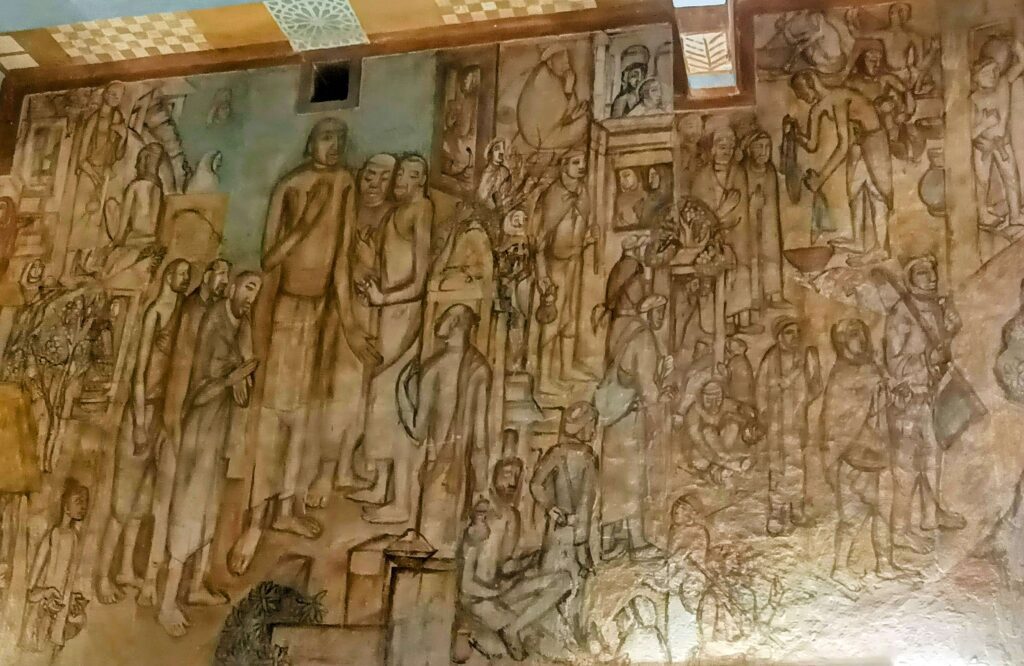
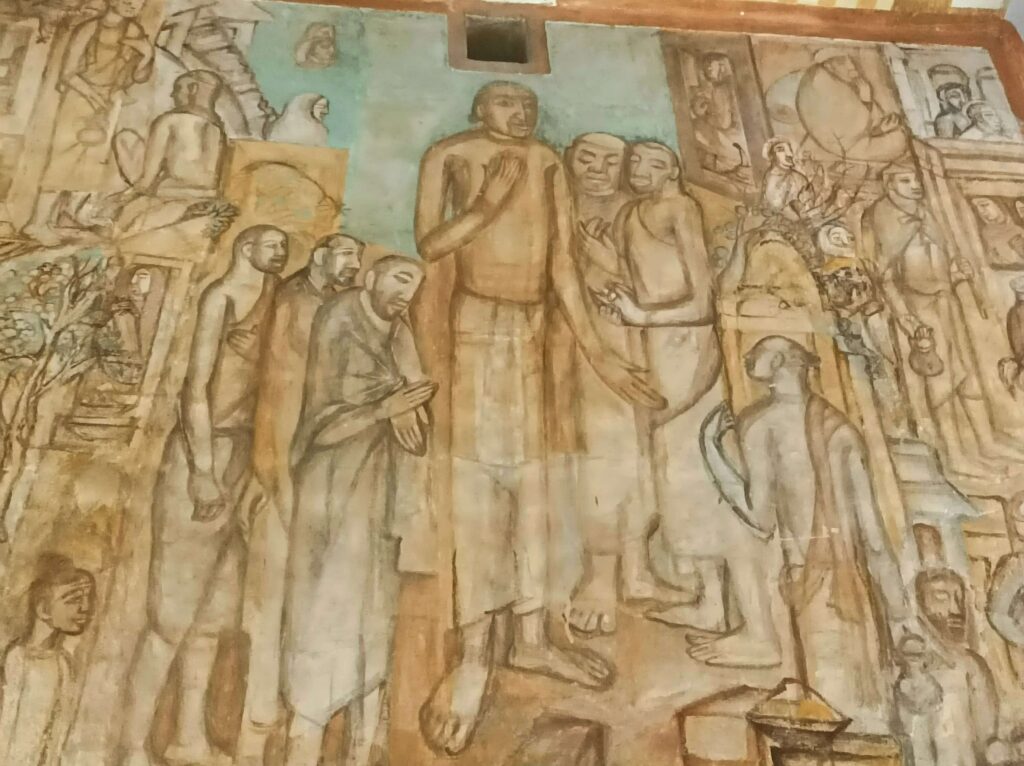
The Fresco-buon technique, introduced to Santiniketan by Pratima Tagore, found its zenith in Mukherjee’s masterful work. This technique, involving the application of pigments to wet lime plaster, created a luminous and enduring surface. It is a term often used interchangeably with Buon Fresco (Italian for “good fresh”). As the plaster dries, the pigments become embedded in it, creating a durable and long-lasting artwork. Despite facing the challenges of blindness in his later years, Mukherjee’s artistic spirit remained undiminished. His ceramic tile mural, created purely through touch, is proof to his extraordinary talent and unwavering passion.
Benode Behari Mukherjee is considered a pivotal figure in Indian modernism. His art, characterized by a unique blend of Indian folk traditions, East Asian aesthetics, and Western influences, carved a distinct path for Contextual Modernism. Unlike his contemporaries, Mukherjee focused on landscapes and nature motifs, incorporating calligraphy and scroll techniques inspired by his travels to Japan. His early mural, “Village Life in Birbhum,” showcased his inclination towards Expressionism and his mastery of East Asian artistic concepts.
Benode Behari Mukherjee’s 80-foot mural, “Life of Medieval Indian Saints,” is a remarkable synthesis of Indian and Western art traditions. It can be categorized as a magnum-opus of Indian Modernism, a movement that sought to reconcile traditional Indian art with contemporary Western aesthetics.
The mural deeply resonates with Indian art traditions, particularly the narrative and devotional styles found in ancient Indian temple art and miniature paintings. The depiction of multiple figures engaged in various activities, creating a dynamic composition, is reminiscent of these earlier styles. Also, Mukherjee’s exposure to European art, especially Cubism, is evident in the mural’s use of geometric forms and overlapping planes. The mural’s monumental scale and its emphasis on the human figure also reflect the influence of Western art.
The genre of the mural can be classified as historical narrative and religious. It presents a panoramic view of medieval Indian history, focusing on the lives and contributions of prominent saint-poets. The mural also carries a strong religious undercurrent, as it celebrates the diversity and harmony of Indian faiths. The creation of this magnificent mural can be attributed to several factors:
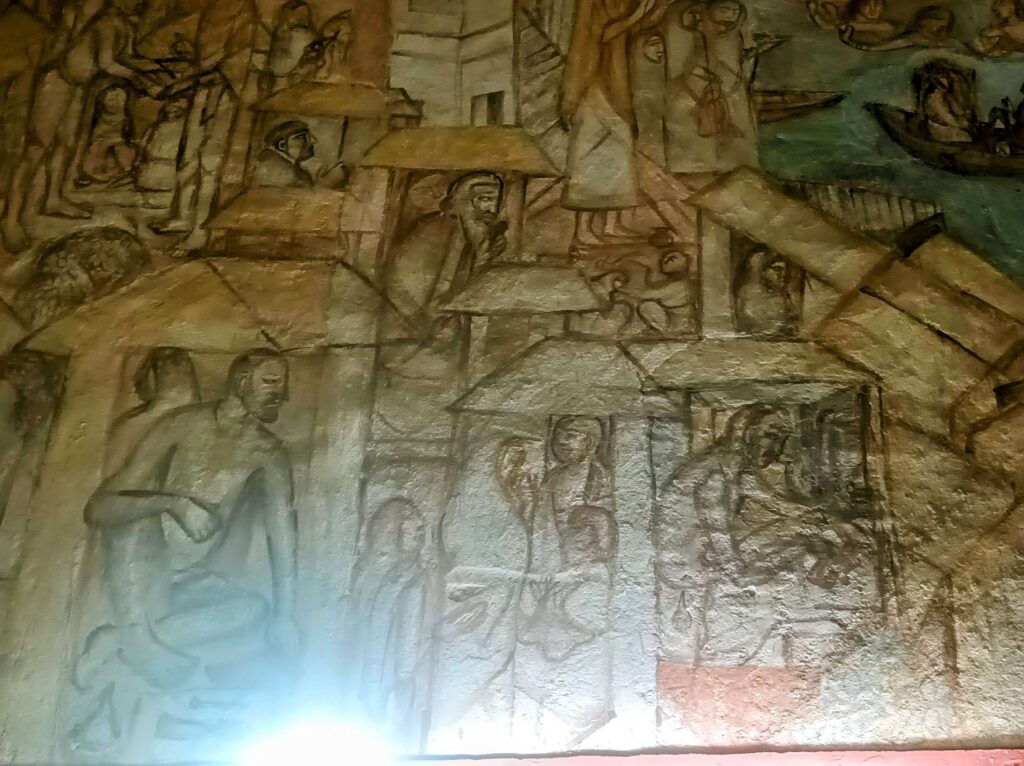
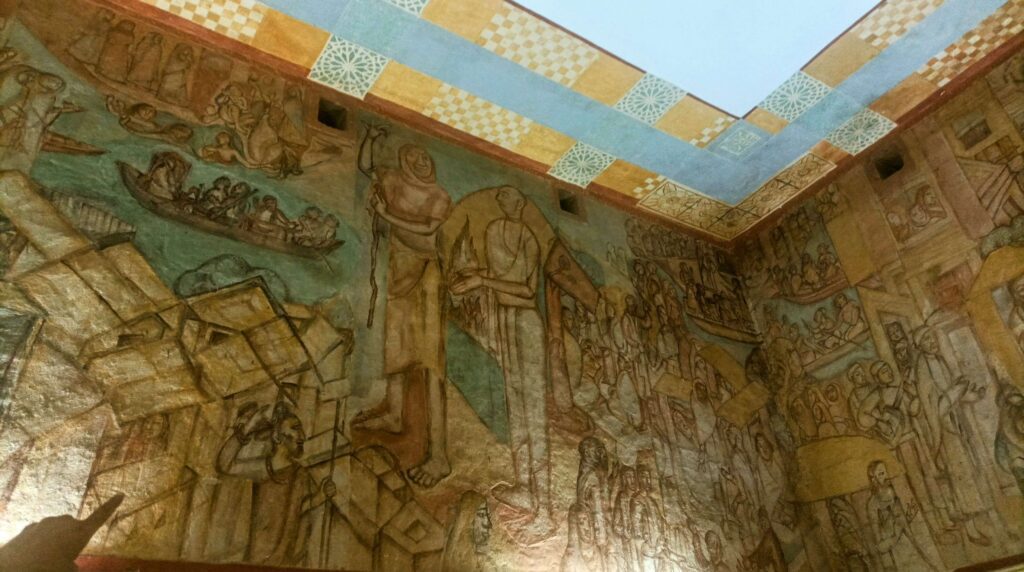
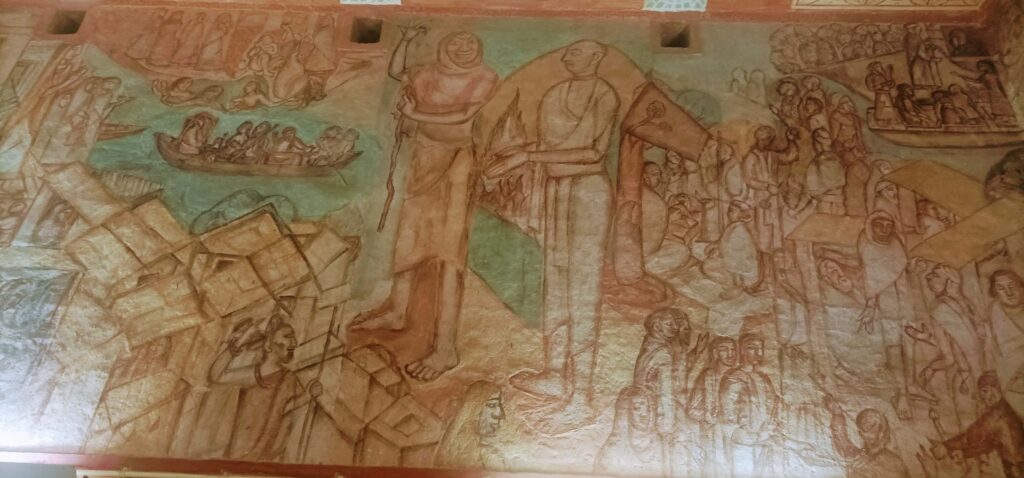
Nationalist fervour: The mural was created in the 1940s, a period of intense nationalist intensity in India. By depicting the lives of medieval Indian saints, Mukherjee aimed to evoke a sense of national pride and unity.
Religious harmony: The mural’s emphasis on the coexistence of different religions was a powerful message of tolerance and unity in a country grappling with communal tensions.
Artistic expression: As a pioneering modern Indian artist, Mukherjee sought to create monumental works of art that would challenge the conventions of easel painting.
The mural was his ambitious attempt to redefine the possibilities of mural painting in India.
Patriotic duty: As a member of the Kala Bhavan community, Mukherjee felt a responsibility to contribute to the building of a new India through art. The mural was his way of serving the nation.
Spiritual experiences: Interactions between saints and their disciples offer intimate glimpses into the teaching and learning process, capturing moments of spiritual transmission. The mural also presents solitary figures immersed in deep meditation, their faces radiating a sense of inner peace and enlightenment. Dramatic scenes of divine revelations are interspersed throughout, conveying the transcendent experiences that shaped the saints’ lives. These elements collectively create a powerful and immersive exploration of the human quest for spiritual realisation.
This grand mural is thus a complex and multifaceted work of art that reflects the socio-political and cultural milieu of its time. It is a validation to Mukherjee’s artistic genius and his commitment to creating art that is both deeply rooted in Indian traditions and relevant to the modern world.
Santiniketan, under the artistic guidance of Nandalal Bose and his successors, has become a crucible of Indian art. The murals that adorn its walls are not merely decorative elements but powerful narratives that reflect the nation’s history, culture, and aspirations.
Visuals sourced by the author

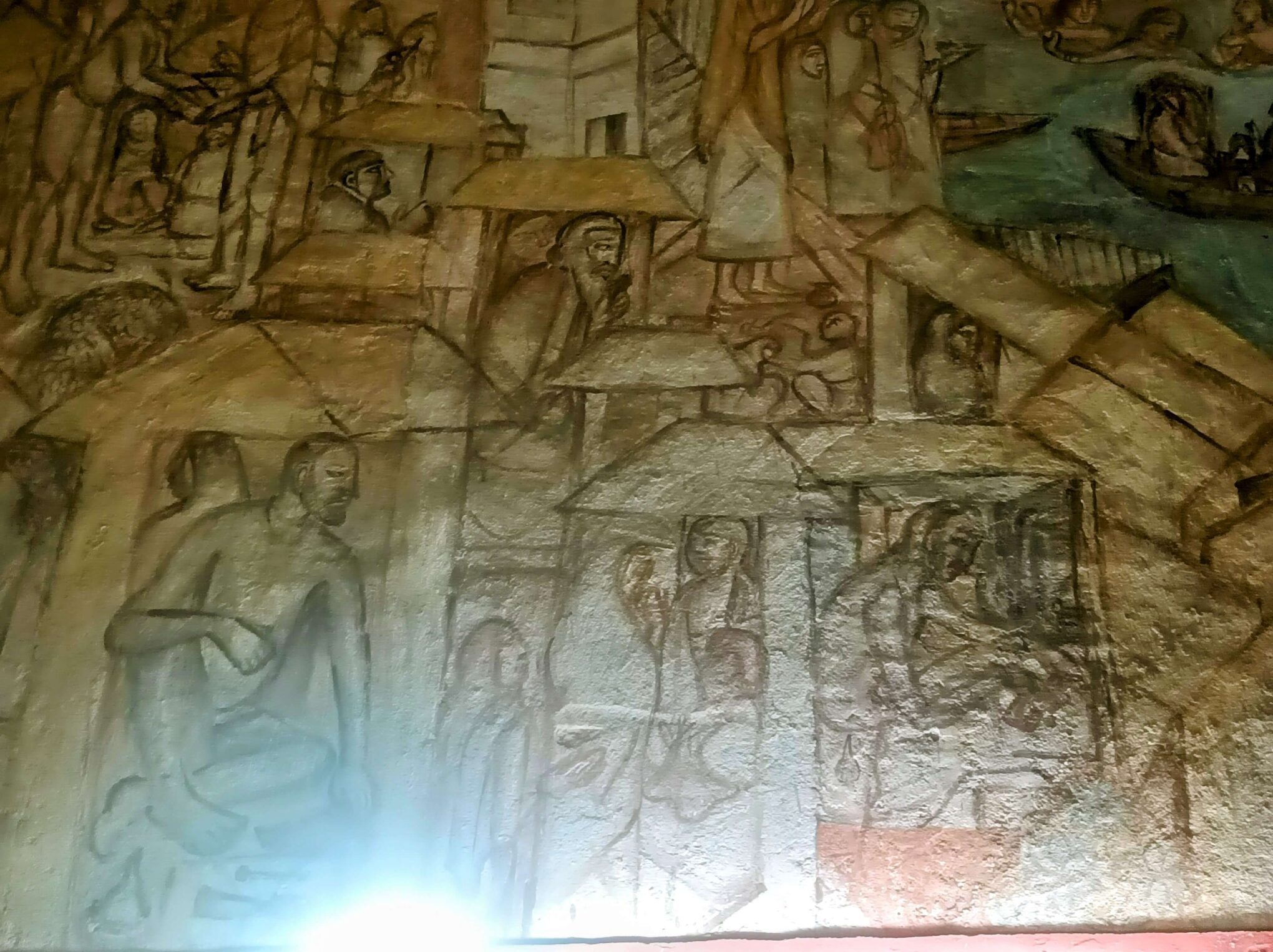














Thank you for an enriching read.
Thank you for saying so, Azam Sir. Glad you liked it.